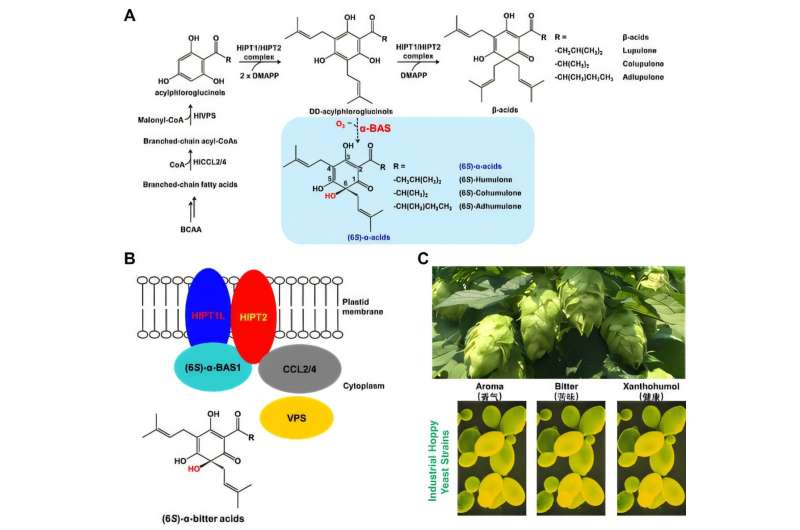Science
Researchers Unlock How Hops Create Beer’s Unique Bitterness

Hops are a crucial ingredient in beer brewing, significantly impacting both flavor and economic value. Researchers from the Chinese Academy of Sciences, led by Prof. Wang Guodong, have made a significant breakthrough in understanding the production of α-bitter acids, which provide beer with its characteristic bitterness. Their findings, published in Plant Communications, clarify the long-standing mystery surrounding the enzyme responsible for the final step in the biosynthesis of these acids.
The female flowers of hops are covered in glandular trichomes that synthesize various metabolites essential for defining beer’s flavor and quality. Terpenes contribute to the aroma, while xanthohumol offers antioxidant properties beneficial to human health. Historically, α-bitter acids also acted as natural preservatives, enhancing the shelf life of beer long before modern brewing methods were developed.
Despite having identified several potential genes linked to α-bitter acid production, the specific enzyme α-bitter acid synthase (α-BAS) remained unverified for over a decade. The research team developed a highly sensitive liquid chromatography–mass spectrometry (LC–MS) method to differentiate between the two chiral forms of α-bitter acids—6S and 6R. Their analysis revealed a predominance of the 6S-type α-bitter acid within hop glandular trichomes.
In their investigation, the researchers found that the precursor of α-bitter acid, known as deoxy-α-bitter acid, undergoes spontaneous oxidation in the presence of air. This process results in a racemic mixture of both 6S and 6R types, complicating the verification of α-BAS’s function. By overcoming these technical hurdles, the team established a yeast heterologous expression system and systematically tested over ten candidate genes.
The results identified HlMO18 as the enzyme that specifically catalyzes the oxidation of deoxy-α-bitter acid, leading to the predominant formation of the 6S form. The study also pinpointed critical amino acid residues vital for the enzyme’s functionality. Moreover, mechanistic analyses indicated that 6S-type α-bitter acid synthase forms a metabolic complex with upstream enzymes, which explains the accumulation of only the 6S form in the glandular trichomes.
This research not only completes the biosynthetic map of α-bitter acids in hops but also enhances understanding of the three major flavor compounds in hops. Following this achievement, the researchers aim to utilize synthetic biology techniques to engineer industrial yeast strains capable of producing “hoppy beer.” This innovative approach could yield beers with authentic hop flavors without the need for traditional hop plants, potentially reducing production costs and enabling customized, flavor-rich beverages.
The implications of this research extend beyond academia, offering valuable insights for the brewing industry. As the team continues to explore synthetic biology applications, the future may hold exciting developments for beer production, catering to both traditional tastes and modern preferences.
For further details, refer to the research conducted by Chengyong Feng and colleagues, published in Plant Communications in 2025 (DOI: 10.1016/j.xplc.2025.101528).
-

 Science3 weeks ago
Science3 weeks agoIROS 2025 to Showcase Cutting-Edge Robotics Innovations in China
-

 World3 weeks ago
World3 weeks agoBravo Company Veterans Honored with Bronze Medals After 56 Years
-

 Politics3 weeks ago
Politics3 weeks agoJudge Considers Dismissal of Chelsea Housing Case Citing AI Flaws
-

 Lifestyle3 weeks ago
Lifestyle3 weeks agoStone Island’s Logo Worn by Extremists Sparks Brand Dilemma
-

 Health3 weeks ago
Health3 weeks agoStartup Liberate Bio Secures $31 Million for Next-Gen Therapies
-

 Health3 weeks ago
Health3 weeks agoTop Hyaluronic Acid Serums for Radiant Skin in 2025
-

 Top Stories3 weeks ago
Top Stories3 weeks agoIndonesia Suspends 27,000 Bank Accounts in Online Gambling Crackdown
-

 Sports3 weeks ago
Sports3 weeks agoMel Kiper Jr. Reveals Top 25 Prospects for 2026 NFL Draft
-

 World3 weeks ago
World3 weeks agoHoneywell Predicts Record Demand for Business Jets Over Next Decade
-

 Lifestyle3 weeks ago
Lifestyle3 weeks agoMary Morgan Jackson Crowned Little Miss National Peanut Festival 2025
-

 Science3 weeks ago
Science3 weeks agoArizona State University Transforms Programming Education Approach
-

 Politics3 weeks ago
Politics3 weeks agoNew Jersey Voters Urged to Register Ahead of November Election









